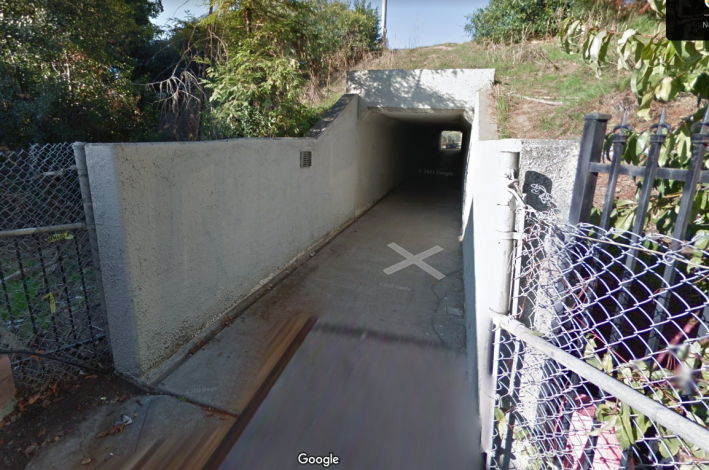Note: GJEL Accident Attorneys regularly sponsors coverage on Streetsblog San Francisco and Streetsblog California. Unless noted in the story, GJEL Accident Attorneys is not consulted for the content or editorial direction of the sponsored content.
Record temperatures. Increasing effects of global warming. Mind-numbing traffic and traffic violence. And the solution from Caltrans and Valley Transportation Authority is more of the same, in this case a plan to spend $153 million over three years to add a massive freeway flyover car ramp, as pictured in the lead image, and other interchange "improvements" for I-280 in San Jose near Winchester Boulevard.

To greenwash things a little, Caltrans and VTA are boasting about a new ADA compliant bike/ped overcrossing that will be part of the project. That sounds great, except that it's only replacing (and albeit improving) a bike and ped crossing that's already there but it's in the way of their new planned off-ramp for cars.

Overall that helps cyclists and pedestrians, because, as the above picture illustrates, the tunnel that's part of the existing bike and ped over-and-then-under freeway crossing is dark, narrow, long and unpleasant. "The existing ped (not really bike) crossing is terrible," opined Betsy Megas with the VTA Bicycle and Pedestrian Advisory Committee, in an email to Streetsblog.

Moreover, "I understand it will land in essentially the same place as it does today. To continue south on Monroe by bicycle, one emerges facing the wrong way for traffic, and not in a spot where drivers are expecting to look for someone," explained Megas, in her statement to Caltrans about the project.
Meanwhile, sidewalks will be widened on the Winchester Boulevard bridge that crosses over Highway 280. That is, of course, also welcome. But that won't be done by taking space from the eight giant lanes for cars (see below), but by widening the bridge itself. It's hard to decipher the bike lane component from Caltrans's documents, but it looks like another Caltrans special, with paint-and-plastic-post-"protected" on-street bike lanes getting added on road space that doubles as breakdown lanes for cars.

Of course, it would cost a lot less than $153 million to widen a bike/ped tunnel and overcrossing (or build a new one at a different location) and add some lights, without adding new car ramps and traffic lanes. It also doesn't cost that much to widen sidewalks or add protected bike lanes (which this project isn't really doing).
But the overall project, and the justification for doing it, is based on outdated, traffic-inducing metrics. "Operating conditions at the intersections were measured using the "level of service" (LOS) concept," note the project's environmental documents on page 48, and in many, many other places. Wait, isn't Caltrans supposed to be moving away from LOS as the primary metric for planning and environmental review?
The planners again use the pseudo-scientific and false assumption that traffic will grow worse if they don't accommodate it with the new car ramps. They make the fantastic claim that the expansion will reduce pollution, reduce noise levels, etc.
Megas asked at a meeting with Caltrans officials Monday night "if the anticipated Vehicle Miles Traveled reduction accounted for potential induced demand, and they say that it was. I'm not sure how they're calculating either effect or what assumptions they're using. I think the justification is basically that drivers are going that way, anyway, but they're ending up going way past the exit and back around the block on surface streets."
Of course Caltrans and VTA are, perhaps intentionally, missing the point of induced demand. The project will induce more driving. If agencies make it easier to drive, more people will drive, creating more traffic and more emissions. It's gaslighting to keep arguing otherwise.
And if they make it harder and scarier to ride a bike, fewer people will ride a bike. The plan "shows no bike lane on westbound Tisch Way just east of Winchester, where there currently is a bike lane," explained Alexandre Gauthier, the local advocate who first forwarded the project study to Streetsblog. "The summary table distills the impact of the project to bicycles down into 'Beneficial due to construction of new bike lanes & wider sidewalks.'"

It's buried in the nearly 300-page document, but as the map above clearly shows, the westbound bike lane Gauthier is flagging (which would be in dark green) is now gone, as this project will transform that section of Tisch Way into a freeway off ramp. Here's the location currently:

In other words, cyclists would gain a bit (an improved bridge) and lose a bit (existing bike lanes eliminated) and would have to contend with increased induced car traffic and more freeway blight. It seems unlikely cyclists will be better off when the project is finished.
The takeaway: Caltrans is still stuck in the freeway-building era of decades ago. The agency needs to wake up to the climate crisis and stop widening roads and interchanges immediately. The agency's mission should be transportation, not accommodating cars and then maybe, occasionally, doing something minor for other modes. Expanding and "improving" freeways is environmentally destructive and it ultimately makes traffic worse.






